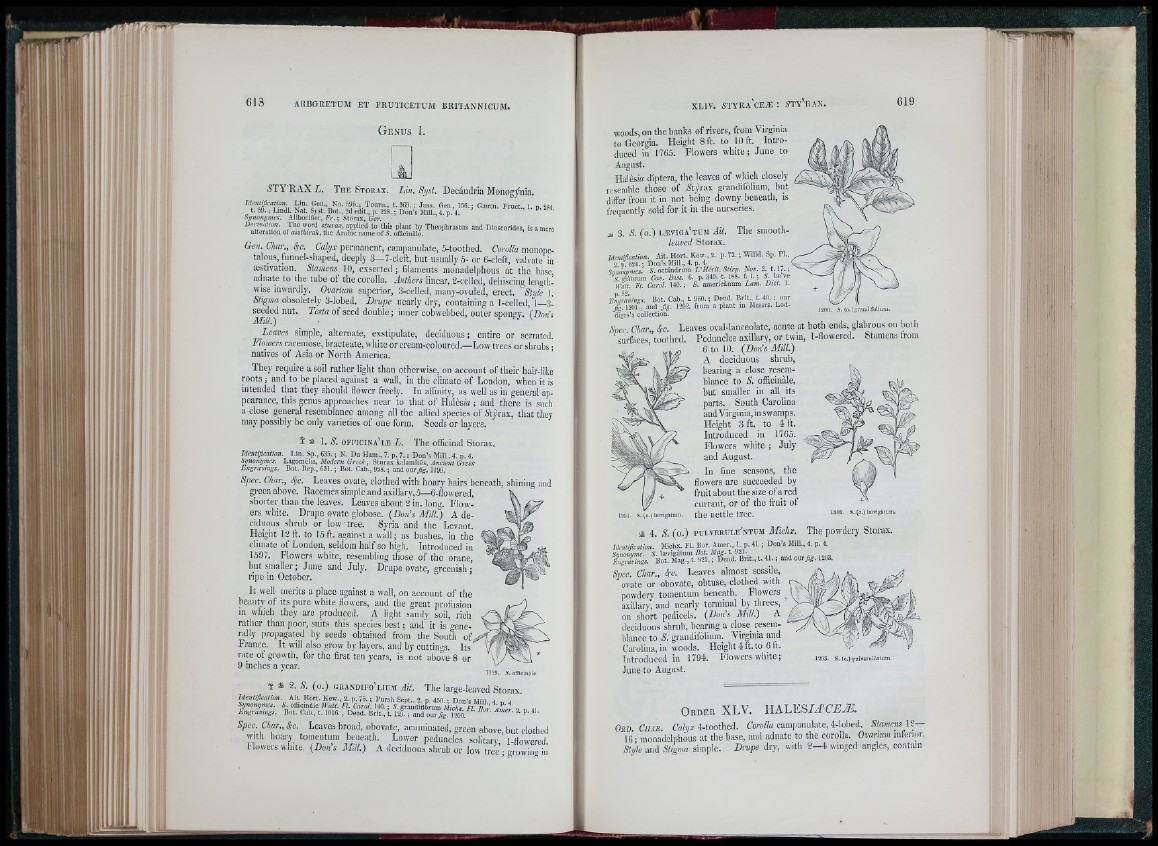
Lin. Syst.■STY'llAX L. T h e S t o r a x . Decándria Monogynia.
Ideniification Lin Gen. No. 595. ; Tourn., t. 399. ; Juss. Gen., 156.; Gærtn. Fruct., 1. p.
t. 69. ; Lmdl. Nat. Syst. Bot., 2d edit., p. 228. ; Don’s Mill 4 p 4 ’ PSynonymes.
Alibocilier, Fr. ; Storax, Ger.
JyCl■'il¡r»t«t¡t1ti0m» . OT'hï ieo n«' .•xorrrdl sturar, applied to .tth. ïi„s —plant tb. y mTyh e.op.hr.ast us and« Dioscori.d. es. is a more
alteration Ot a-ssìAira*, the Arabic name Of 5. officinàle.
Gen. Char., 4c. Calyx permanent, campanulate, 5-toothcd. Corolla monopetalous,
funnel-shaped, deeply 3—7-cleft, but usually 5- or 6-cleft, valvate in
æstivation. Stamens 10, exserted ; filaments monadelphous at the base
adnate to the tube of the corolla. Anthers linear, 2-celled, dehiscing length’
wise inwardly. Ovarium superior, 3-cc!led, many-ovuled, erect. Style 1.
Stigma obsoletely 3-lobed. Drupe nearly dry, containing a 1-celIed, 1 3-
double; inner cobwebbed, outer spongy. (Doris
eaves simple, alternate, exstipulate, deciduous; entire or serrated.
Llowers racemose, bracteate, white or cream-coloured.—Low trees or shrubs ;
natives of Asia or North America.
They require a soil rather light than otherwise, on account of their hair-like
roots ; and to be placed against a wall, in the climate of London, when it is
intended that they should flower freely. In affinity, as well as in general appearance,
this genus approaches near to that of Halèsia ; and there is such
a close general resemblance among all the allied species of ¿"tyrax, that they
may possibly be only varieties of one form. Seeds or layers.
Î afe 1. Ó*. o f f i c i n a ' l e L. The officinal Storax.
Identification. Lin. Sp., 635. ; N. Du Ham., 7. p. 7. ; Don’s Mill 4 p 4.
Synonymes. Lagomélìa, Modej-n Greek; Sturax kalamites. Ancient Greek
Engravings. Bot. Kep., 631. ; Bot. Cab., 928. ; and our/g-. 1199.
Spec. Chnr., 4i- Leaves ovate, clothed with hoary hairs beneath, shining and
green above. Racemes simple and axillary, 5—6-flowered,
shorter than the leaves. Leaves about 2 in. long. Flowers
white. Drupe ovate globose. (Don’s Mill.) A deciduous
shrub or low-tree. Syria and the Levant.
Height 12ft. to J5ft. against a wall; as bushes, in the
climate of London, seldom half so higli. Introduced in
1597. Flowers white, resembling those of the orane,
but smaller ; June and July. Drupe ovate, greenish ;
ripe in October.
It well merits a place against a wall, on account of the
beauty of its pure white flowers, and the great profusion
in which they are {>roduced. A light san.ly soil, rich
rather than poor, suits this species best ; and it is generally
propagated by seeds obtained from the South of^
France. It will also grow by layers, and by cuttings. Its
rate of growth, for the first ten years, is not above 8 or
9 inches a year.
liy9, s. oflieinale
¥ * 2. S. (o.) g ra n d ifo 'lium Ait. The large-leaved Storax.
Ideniification. Ait. Hort. Kew., 2. p. 75. ; Pursh Sept.. 2. p 450 • Don’s IVTiii a ^ a
Synonymes. S officinàle Walt. Fl. Carol. HO. ; S. gkndiflòrum Mick flF l it:- hnlJt' o , a,
Engravings. Bot. Cab., t. 1016., Dend. Brit., t. 129, ; and o u r /g ! itoó. 2- P- “HSpec.
Char.,4c. Leave,s broad, otavate, acuminated, green above, but clothed
W ith hoary tomentum beneath. Lower peduncles solitary 1-Howereil
Howeits wiiite, {Don’s Mill.) A deciduous shrub or low tree’ - growim. hi
woods, on the banks of rivers, from \ irginia
to Georgia. Height 8 ft. to 10ft. Introduced
in 1765. Flowers white ; June to
August.
Ilalèsia díptera, the leaves of which closely
resemble those of Ntyrax grandifòlium, but
differ from it in not being downy beneath, is
frequently sold for it in tlie nurseries.
M 3. S. (o.) l®viga' tum Ait. The smooth-
leaved Storax.
Mentijlcation. Ait. Hort. Row., 2. p. 72. ; Willd. Sp. PI.,
0 p 624.; Dnn s Mill., 4. p. 4.
Sunonvnes. S. octándrum L 'IIérit. Stir)
F r. r n . , /Ij'ot fi.
Wall. Fl. Carol. 140.; S. americànum Lam. D id . 1.
& Ì i™ ì* s . Boi. Cab., t. 860. ; Dend. Brit., t. 40. i our
1201., and fig. 1202. from a plant in Messrs. Loddiges’s
collection. 1200. s. (o.iKraiidifoliuui.
Spec Char 4c. Leaves oval-lanceolate, acute at both ends, glabrous on both
surfaces*’too(hcd. Peduncles axillary, or twin, I-flowered. Stamens from
6 to 10. (Don’s Mill.)
A deciduous shrub,
bearing a close resemblance
to S. officinàle,
but smaller in all its
parts. . South Carolina
and Virginia, in swamps.
Height 3 ft. ^ to 4 ft.
Introduced in 1765.
Flowers white ; July
and August.
In fine seasons, the
flowers are succeeded by
fruit about the size of a red
currant, or of the fruit of
12U1. s.(o.)!aivigittum. the nettle tree.
afe 4. S. (o.) pulverule'ntum Michx. The powdery Storax.
hk-nlification. Michx. Fl. Bor. Amer., 1. p. 41. ; Don’s Mill., 4. p. 4.
^ingmvings. ^ B o r ìv iS r t - \ 5 1203.
Siiec. Char., 4c. Leaves almost sessile,
ovate or obovate, obtuse, clothed with
powdery tomentum beneath. Flowers ^
axillary, and nearly terminal by threes,
on short pedicels. (Don’s Mill.) A
deciduous shrub, bearing a close resemblance
to S. grandifòlium. Virginia and
Carolina, in woods. Height 4 ft. to 6 ft.
Introducedin 1794. Flowerswhite;
June to August.
1202. S. (o.) Isciigituni
1203. S. (o.) pulveiaìéntum.
O r d e r X L V . H A L E S / aI'CJS»®.
OXD CUAR. Ca/w 4-toothed. Coro/fe campanultite, 4-lobed. Stamens U—
16 • monadelphous at the base, and adnate to the corolla. Ovarmm inferior.
Style and Stigma simple. Drupe dry, with 2—4 winged angles, contain